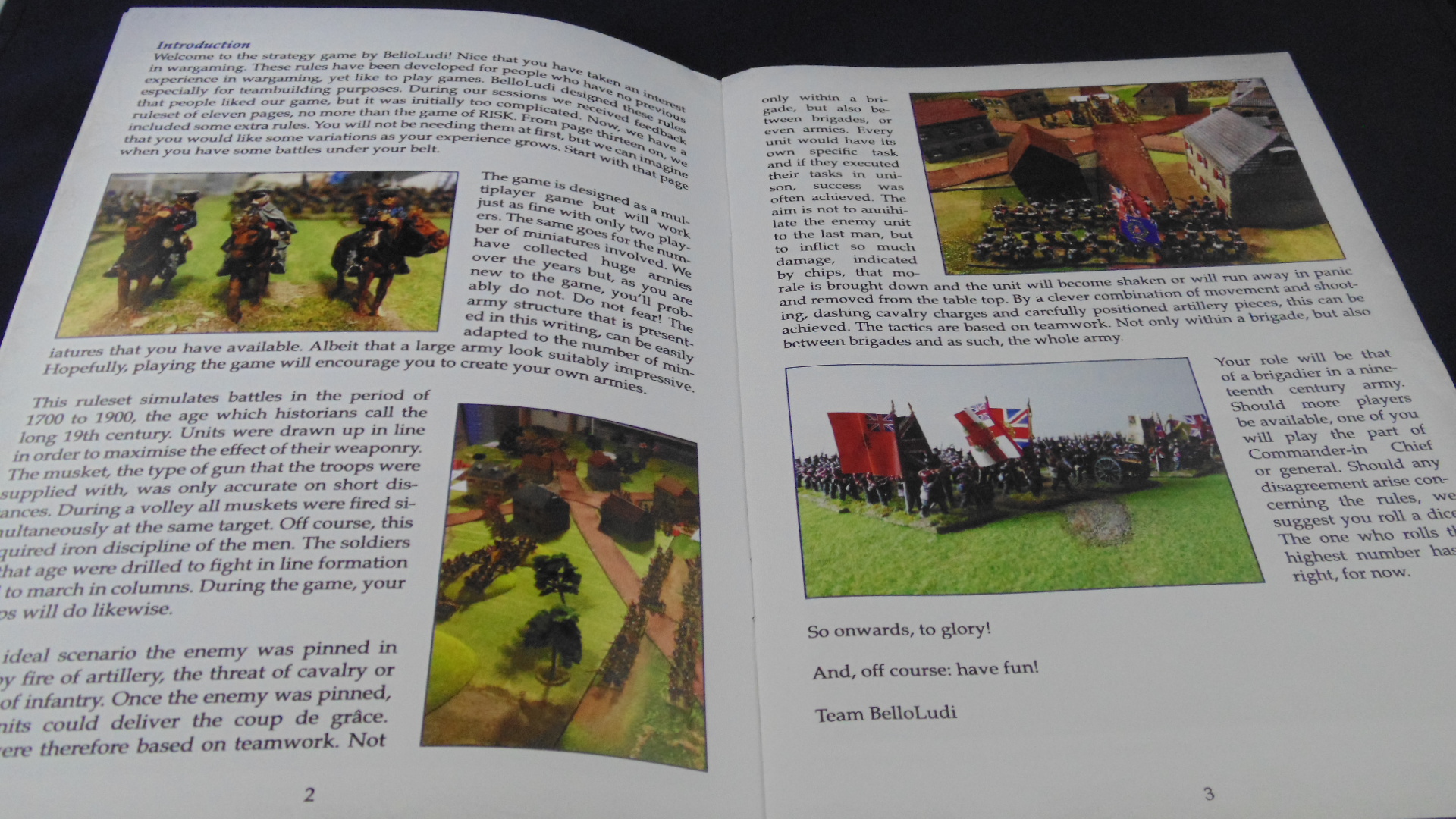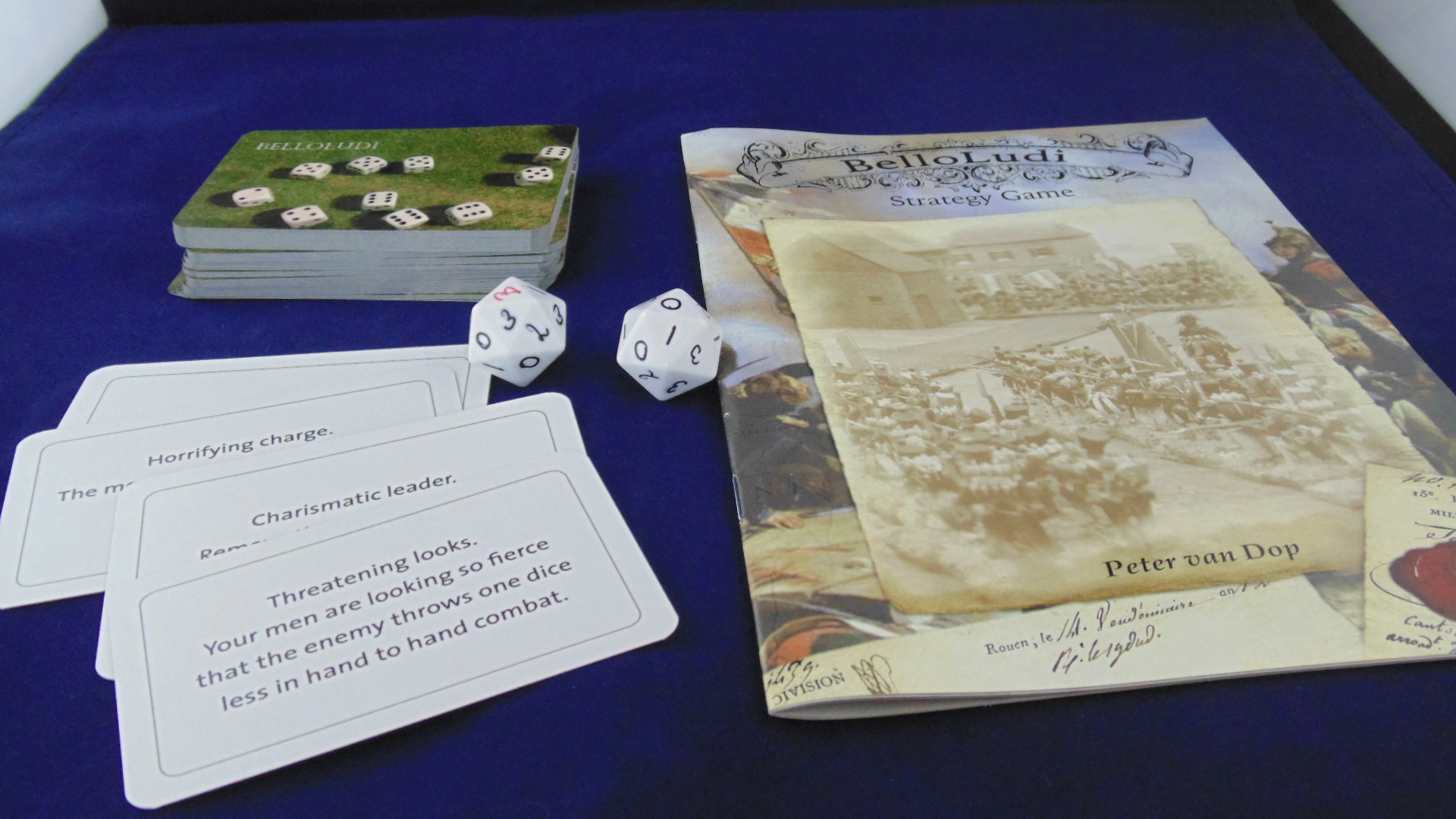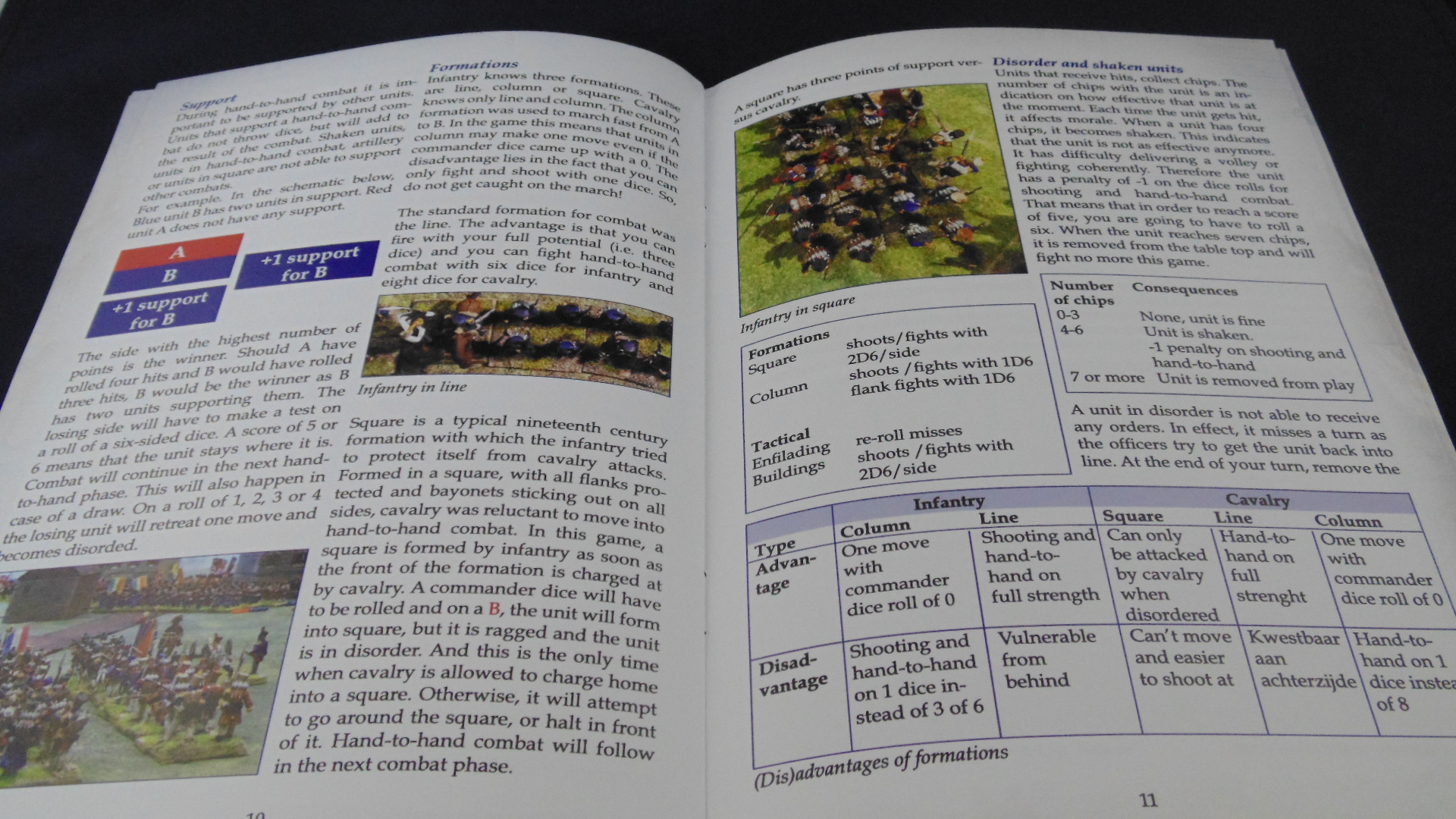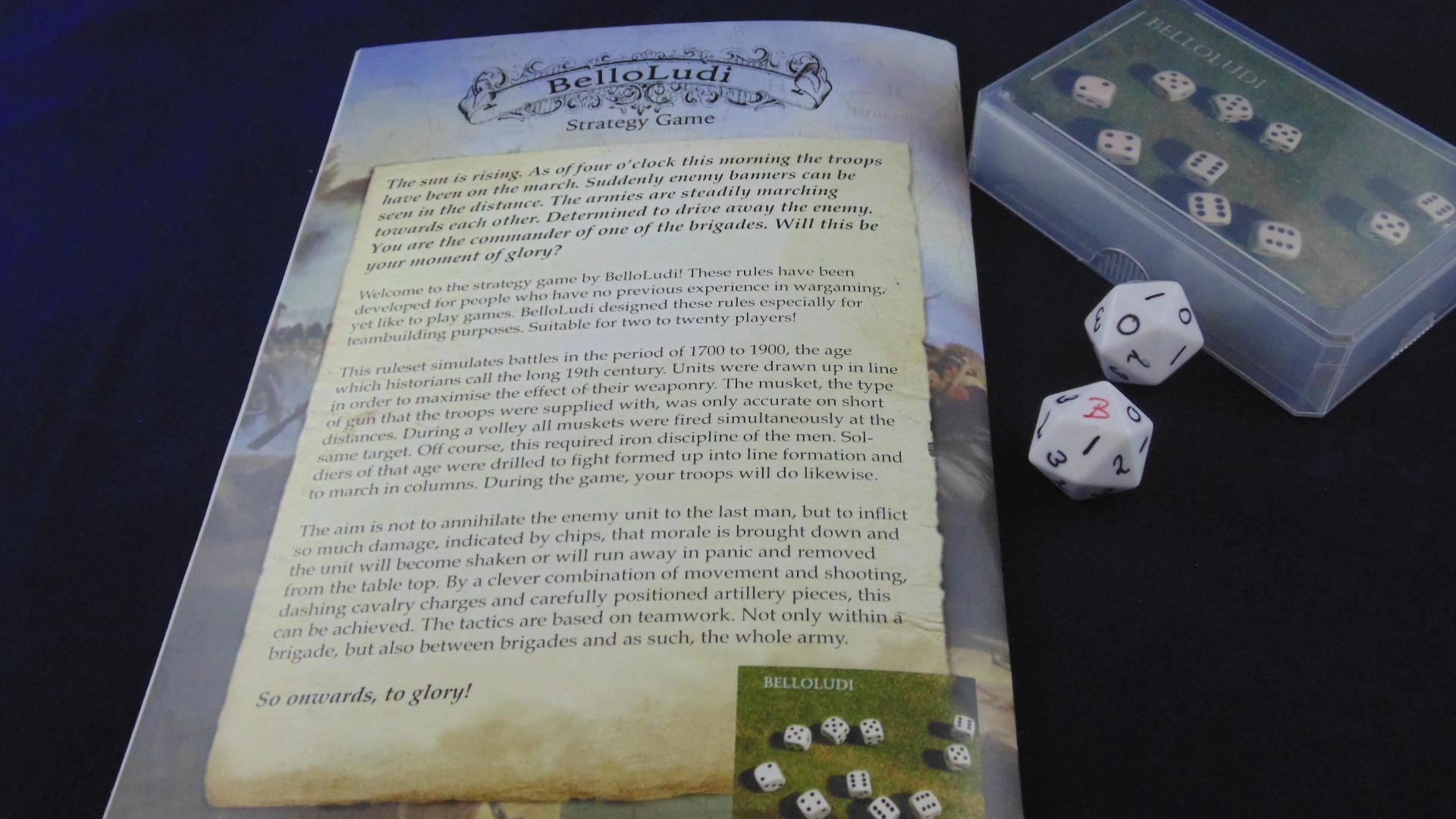BelloLudi The Streamlined Strategy Game For Horse & Musket
October 1, 2020 by avernos
BelloLudi is a strategy wargame with a difference, it's not aimed directly at wargame players but instead has been written for as a tool to aid team building and encourage people who enjoy games to play wargames. The result of this is Peter van Dop has written a set of rules in BelloLudi that are simple to pick up and learn and can be played by large multiplayer teams.
BelloLudi // Peter van Dop
While you can now pick up the PDF version of the rules from Peter's website the game has a couple of other components to make it play to the fullest. A set of d20 Commander dice and a deck of cards that are used to add an element of fog and friction to the game. The Rules themselves is a fifteen-page book, but the main rules are only seven pages of that. When I said they would be easy to explain I wasn't kidding. The last three pages contain expanded rules that can be added as desired, more on that at the end.
Game Components // BelloLudi
So how does the game itself play? I'm glad you asked voice in my head. Starting with the army every player will command either a Cavalary or an Infantry Brigade. The Cavalry Brigade is made from three squadrons each containing four stands plus supporting artillery, the Infantry Brigade is made from four battalions consisting of six stands in each with supporting artillery. These are the building blocks for your armies.
Once you have your armies built the turn sequence is;
- Make a plan
- Roll for initiative
- Command, movement of units
- Shooting
- Hand-to-Hand
As I said it is made for team-building exercises and as such perfect for participation games, beginning the turn with both commanders talking to the sub-commanders to work out what they need to do. After that a d6 roll for initiative will decide who will go first. It is I-go, you-go with one side performing their turn before the opponent takes over. Units can be moved individually or as Brigade moves and this is where the Commander dice come in.
They are marked off 0,1,2,3, B and when an order is made the die is rolled to see how it will be performed, 0 means that it isn't, 1, 2, 3 tells you that you make that many moves and a B is a Blunder. Apart from stopping the Brigade Commander from issuing any further orders this turn the Blunder also requires a roll on a d^ chart which could see the target of the order retreating, shuffling off to one side or even charging hell for leather to the horizon like the Light Brigade.
Now these are the very basics there are some modifiers, I know that some people I've spoken to in the past don't like C&C games that prevent a unit from activating in the face of the enemy and this game has something to counter that. Units that begin their turn within 12" range of the enemy get a free order without a command roll to evade or if they want to chance it charge the incoming enemy unit!
Movement and Formations // BelloLudi
There are also formations to be taken into account line, column, and squares for infantry. There are reasons they exist and they can be exploited to their fullest in the Napoleonic manner, columns will move even on a 0 roll for example so they should always get where they are going.
Squares can be formed as a charge reaction when the cavalry are bearing down from the front, in which case they'll balk at charging and continue past the formed unit, just be careful you don't blunder a disorganised square is easy prey to horsemen.
Shooting and Melee is made on d6 rolls with 5,6 being required to hit although there are modifiers for this if you are disordered or have managed to get into a position to fire along the length of your opponent's line, for example. Each time a unit is hit it takes a chip and when they reach four the unit is shaken and on seven they are removed. If a target is hit by all the dice in a single volley it becomes disordered by an unusually devastating volley which is a nice touch.
Commander Cards
The card deck contains twenty-one positive cards, twenty-one negative and twelve Commander cards. These are dealt out one to every player each turn and they can be played at any time. They add a twist to the game and allow that competitive edge to come out between the teams as you can choose when to play them or to hold onto cards for the following turn. The positive cards may remove chips from your unit or can inflict additional hits on an opposing unit. While the negative cards can stall an advance or remove the artillery for a turn. The commander cards are used to remove remain-in-play effects.
The introduction of the cards is a lot of fun and often they are written slightly tongue in cheek. A drunken officer failing to report stalls the Brigade that sort of thing.
Extra Rules
If you are a wargamer already the extra rules are probably going to be introduced in short order. The first page includes Terrain rules, from roads to rivers, forests and defended obstacles, it's all in here to make the game more realistic and tactical. The remaining pages introduce the concept of more detailed army composition. Elite Troop and Militias appear alongside Lancers, Heavy Cavalry and there is even a points system.
In summing up then what do I think about BelloLudi? I'm glad you're still interested voice I made up.
Well while it is certainly light on rules that is not a detriment for the game. It shares similarities to Black Powder albeit with a much simpler statline and mechanics so introducing new players will be very easy indeed. Likewise playing those large Con games where you need to shepherd 20 people who have never played will be much easier with this ruleset over the vast majority of others out there.
People wanting a full-on Napoleonic experience will probably be best to look elsewhere but if you have always thought about getting into that horse & musket era and the larger sets are daunting there is a lot in these rules that I really like. It gives the feel and flavour of what you imagine when you think of that period. The concepts of fog and friction for a lot of players is also alien, many come into historicals from fantasy and sci-fi where they always get to do whatever they want at all times. The Blunder dice introduces this with a simple roll, no Leadership, no Command radius to explain an elegant one roll and that's what you can do this turn.
I would suggest picking it up, the expense isn't that much and you can download sheets of markers that stand in for French and British armies so you could play before you buy any minis and see if it is what you expected. If it is look for more to come, Peter announced yesterday that they have printed De Re BelloLudi Cards. These are a set of Commander Cards for Ancients and Medieval Games, no rules yet but they are available if you want to add them to an existing game you play to mix things up a bit.
"The introduction of the cards is a lot of fun and often they are written slightly tongue in cheek. A drunken officer failing to report stalls the Brigade that sort of thing."
Supported by (Turn Off)
Supported by (Turn Off)
Supported by (Turn Off)

































![How To Paint Moonstone’s Nanny | Goblin King Games [7 Days Early Access]](https://images.beastsofwar.com/2024/12/3CU-Gobin-King-Games-Moonstone-Shades-Nanny-coverimage-225-127.jpg)











































Leave a Reply